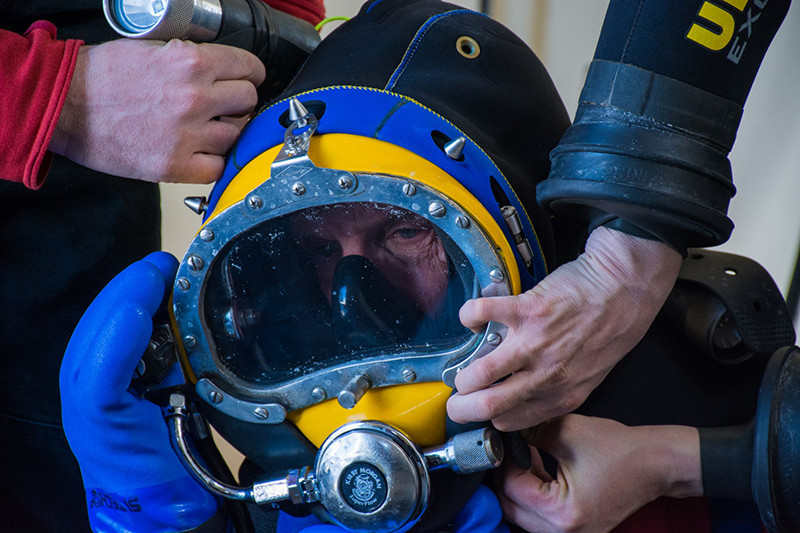
Photo Credit: Mike Lucibella
|
Bill Stone gets ready to dive underneath the ice to ensure the robot isn’t tangled, and is ready for its mission.
|
A Robotic Rehearsal for Interplanetary Exploration (cont.)
By Michael Lucibella, Antarctic Sun Editor
Page 3/3 - Posted July12, 2016
Another advantage to practicing on Earth is that it’s easy to double-check what the sensors on the robot are reading against a more comprehensive laboratory analysis.

Photo Credit: Mike Lucibella
Evan Clark steers ARTEMIS under the ice using a videogame controller as he watches the live camera feeds and sonar images sent back from the robot.

Photo Credit: Mike Lucibella
Britney Schmidt (right) and Jade Lawrence share a laugh while tending the ropes and cables as the ARTEMIS robot swims out under the ice.
“We can take water samples up at the ice-ocean interface, or anywhere else along our track, and take them back to the lab and analyze what our remote or our onboard instruments are saying, versus the ground truth from water samples,” Schmidt said.
Finding life in the ocean around McMurdo is not difficult. The waters under the sea ice teem with a wide variety of organisms and the robot offered scientists a chance to learn more about them and their environment. The project’s timing was fortuitous because late November, when the team was in the field, is also when the ocean ecosystem undergoes major changes as the austral summer sets in.
“The sub-ice shelf is a non-photosynthetic ecosystem, and where that transition is to the photosynthetic ecosystem is actually only becoming measurable in a big way [in November] because the [sea] ice is getting thinner and the snow is going away,” said Peter Doran, a professor of geology and geophysics at Louisiana State University.
The sunlight that filters through the ice is an important source of nourishment to the organisms that live underneath. As in most ecosystems, photosynthetic plants and algae absorb the rays of the sun and convert them into energy, forming the foundation of the food chain.
In the Antarctic, the cycle is a bit more complicated than at lower latitudes because of the months of total darkness in the winter and constant light in the summer. In addition, snow covers much of the sea ice in the beginning of the summer, blocking sunlight from filtering through. Usually by late November enough light starts to reach the waters beneath the ice that it spurs massive growth in the algae underneath.
“This will be the first time you can actually look at the fine-scaled changes in light conditions under the sea ice covering, and how the organisms respond to those changes in light levels,” Doran said. “You can’t do that without a submarine of some kind.”

Photo Credit: Mike Lucibella
Chris Flesher (left), Bill Stone, Mark Scully and Evan Clark monitor the progress of the robot underneath the sea ice as real-time data about the ocean’s characteristics is projected onto the screen behind them.
ARTEMIS carries a special light sensor to record how much of the light that plants need for photosynthesis passes through the ice. As it moves through the water, the robot collects more data over a greater area than past techniques, which could only observe conditions around gaps in the ice.
“No one’s been able to do that before, because it’s all been hole-driven. One hole here one hole there,” Doran said. “Doing long transects and getting the biogeochemical gradients is a completely novel thing.”
It’s a lot of science to fit into a single season in Antarctica, and the researchers put in long hours to get as much data as they could. Between the robot launch, systems checkout, its ten-hour mission plus recovery, working 20 hours a day or more was not uncommon for the team.
“We got some important data, we checked out the vehicle, got it working and have a lot of lessons for future work,” Schmidt said.
Since returning from Antarctica, the team has been sifting through the vast amounts of data they collected over their three seasons of work. They’re hoping to release the bulk of their work within the next year or so.
“As soon as we have this data processed in interesting ways, we’ll publish it but we’ll also archive the data so other people can use it,” Schmidt said. “We’re trying to get the science out to the community, trying to get the engineering designs out to the community so people can benefit from our lessons learned, and we’re going to try to push these technologies forward in a variety of ways.”
There are still a number of technical challenges that scientists will need to overcome before any future interplanetary submarine can be built, not least of which is building a machine that can drill through miles of ice and deploy a small submarine. Past robots have addressed different parts of this problem individually, in the hopes of eventually putting together a comprehensive robotic system that can do everything.
“What we’re doing here with the SIMPLE program, using ARTEMIS, using SCINI, using Deep-SCINI, using Icefin, using all these underwater vehicles, is to try to push the envelope on the technology,” Schmidt said. “We need underwater and under-ice exploration to get to that point so that we can take those technologies and get to Europa.”
Previous
1
2
3
Next








